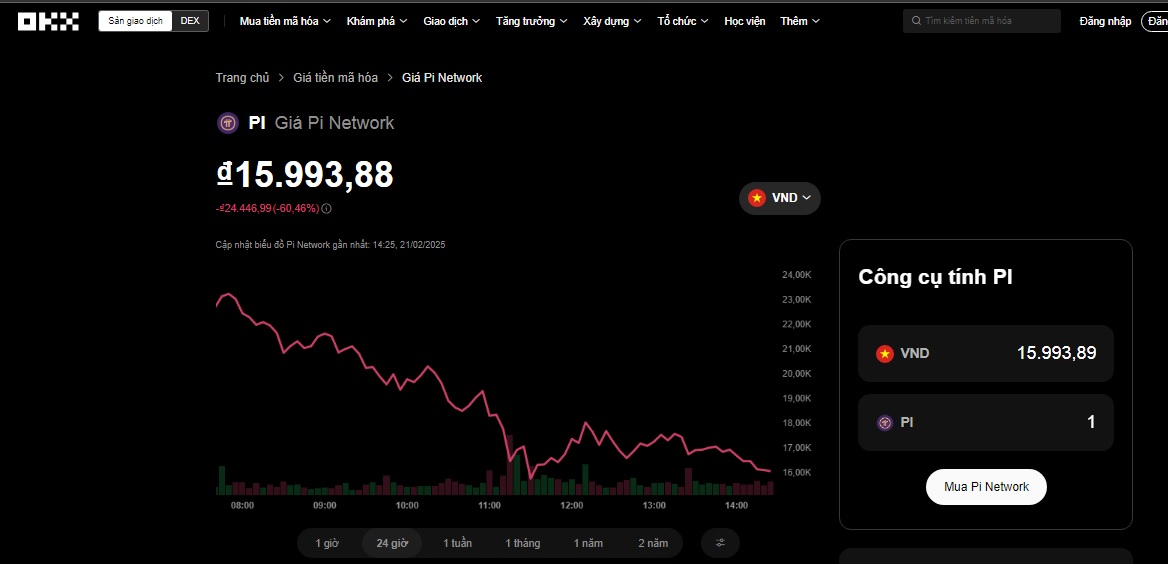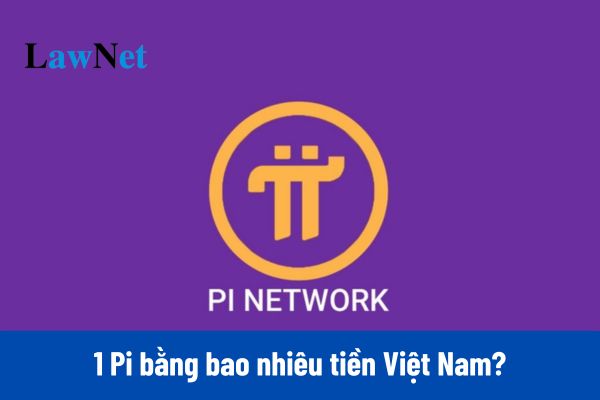What is the price of 1 Pi in Vietnamese dong today? How does Pi Network operate? Which agency leads the research on tax-related legislative documents concerning cryptocurrency in Vietnam?
What is the price of 1 Pi in Vietnamese dong today? How does Pi Network operate?
Below are details about the Pi Network that you may refer to:
1. 1 Pi Equals How Much in Vietnamese Dong?
To calculate the value of 1 Pi in Vietnamese Dong (VND) as of today, February 21, 2025, we rely on the latest actual transaction price information from the OKX exchange (where Pi was just listed on February 20, 2025) and the current USD/VND exchange rate, specifically as follows:

Pi Network price today is listed on the OKX exchange at 14:31
According to the listing price on the OKX exchange, 1 Pi is approximately equivalent to 15,993 VND.
| Note: The value of 1 Pi can fluctuate significantly during the day due to its new listing on the exchange, so this number is only for reference at the current time. If you need a more accurate price at a specific time of the day, please check directly on the OKX exchange or reputable cryptocurrency data sources and apply the latest USD/VND exchange rate from the bank. |
2. How Does Pi Network Operate?
Pi Network is designed to allow users to "mine" cryptocurrency directly on mobile phones without specialized hardware or high energy consumption. The project emphasizes simplicity, ease of use, and aims to build a large community before developing into a real economic ecosystem.
(1) Development Phases
Pi Network goes through major phases:
- Phase 1 (2019 - 2021): App launch and test mining. Users download the Pi Network app, register, and begin "mining" by pressing a button on the app every 24 hours. At this stage, Pi does not have real value, only an accumulated balance in the app.
- Phase 2 (2021 - 2024): Network building and user verification (KYC - Know Your Customer). Users are encouraged to invite more members to increase mining speed, but Pi is not yet tradable on exchanges.
- Phase 3 (Mainnet - February 20, 2025): The mainnet is launched, Pi becomes a real cryptocurrency with trading ability on exchanges (such as OKX). Pi accumulated previously is transferred to an official wallet after completing KYC.
(2) Method of Mining Pi
- Pi Network App: Users download the app from Google Play or App Store, create an account using a phone number or Facebook.
- Basic Mining: After registering, users press the "mine" button (lightning icon) every 24 hours to maintain a mining session. The initial base mining speed is 0.1 Pi/hour (may change over time).
- Increasing Mining Speed:
+ Security Circle: Add 3-5 trusted users to increase mining speed (usually adds 0.05-0.2 Pi/hour).
+ Inviting New Members: Each invited member (who is active) increases the individual's mining rate by about 25%.
+ No Resource Consumption: Unlike Bitcoin (using Proof of Work), Pi uses the Stellar Consensus Protocol (SCP), which does not require significant computing power, instead relying on network user consensus.
(3) Technical Operating Mechanism
Pi Network is based on blockchain technology, but has distinctive features:
- Proprietary Blockchain: Pi uses a variant of the Stellar blockchain, optimized for transaction speed and energy conservation.
- Pre-mainnet Phase: Before the main network operates, all Pi is stored on the centralized servers of the development team. Post-mainnet (February 20, 2025), data is transferred to a decentralized blockchain.
- KYC and Fraud Prevention: Each user must verify their identity to avoid multiple fake account creations. Only Pi from KYC-ed accounts is transferred to the mainnet wallet.
(4) Ecosystem and Usage Purpose
- Real Transactions: After going on mainnet, Pi can be used to buy and sell goods/services within the Pi ecosystem (if businesses accept) or trade on exchanges like OKX.
- Pi Browser Application: An accompanying platform allows users to access decentralized apps (DApps) within the Pi ecosystem, such as marketplaces, games, or financial services.
- Long-term Vision: The development team aims to turn Pi into a globally popular digital currency, with a target of billions of users.
(5) Strengths and Limitations of Pi Network
- Strengths:
+ Accessibility: Anyone can participate without investing in equipment.
+ Energy Efficient: Does not harm the environment like Bitcoin mining does.
+ Large Community: Tens of millions of users worldwide (estimated over 50 million by 2025).
- Limitations:
+ Sustainability: Actual value depends on whether Pi is widely accepted.
+ Transparency: The development team has been criticized for lacking clear information about the economic plan and Pi distribution.
+ Legal Risks: In many countries (like Vietnam), cryptocurrency has not been officially recognized, making legal use challenging.
Thus, Pi Network operates by allowing users to "mine" cryptocurrency for free on phones through an app, based on consensus mechanisms rather than complex calculations.
After the mainnet launch (February 20, 2025), Pi shifted from an experimental project to a tradable cryptocurrency. However, its long-term success depends on building the ecosystem, community trust, and market acceptance.
Note: The information is for reference only and should not be considered investment advice. Investors should conduct their research and consider carefully before making decisions!

What is the price of 1 Pi in Vietnamese dong today? How does Pi Network operate? (Image from Internet)
Which agency leads the research on tax-related legislative documents concerning cryptocurrency in Vietnam?
Based on Section 4 Part 2 of Decision 1255/QD-TTg in 2017 on approving the Scheme for Completing the Legal Framework for Managing and Handling Virtual Assets, Electronic Money, and Virtual Money issued by the Prime Minister of the Government of Vietnam, the regulation is as follows:
TASKS
...
- Research, propose amendments, supplements, new issuance of legislative documents on tax related to virtual assets, virtual money.
a) Activity: Research, propose amendments, supplements, new issuance of legislative documents on tax related to virtual assets, virtual money.
b) Output: Dossier proposing the construction of tax-related legislative documents for virtual assets, virtual money according to the provisions of the Law on Promulgation of legislative documents of 2015.
c) Completion time: June 2019.
d) Lead agency: Ministry of Finance.
e) Coordinating agencies: Ministry of Justice, Ministry of Information and Communications, Ministry of Industry and Trade, Ministry of Public Security, Ministry of Science and Technology, Ministry of Planning and Investment, State Bank of Vietnam, Supreme People's Procuracy, Supreme People's Court, Vietnam Chamber of Commerce and Industry, Vietnam Small and Medium Enterprise Association, and other relevant ministries and central authorities.
Therefore, the Ministry of Finance is tasked with researching, proposing amendments, supplements, and new issuance of tax-related legislative documents concerning virtual assets, virtual money.
What are the responsibilities of the Ministry of Finance of Vietnam in strengthening the management of cryptocurrency operation?
Based on Section 2 of Directive 10/CT-TTg in 2018 to limit risks and consequences for society, promptly detect, prevent, and handle legal violations, the Prime Minister of the Government of Vietnam requires the Ministry of Finance to focus on implementing the following tasks:
- Direct public companies, securities companies, fund management companies, and securities investment funds not to carry out activities of issuance, trading, and brokerage of illegal cryptocurrency transactions, complying with anti-money laundering regulations.
- Study practices and international experiences to propose measures for capital mobilization activities through initial coin offerings (ICO).
- Lead, cooperate with relevant agencies to have measures, limit import, manage equipment, and machinery for the purpose of cryptocurrency mining.

